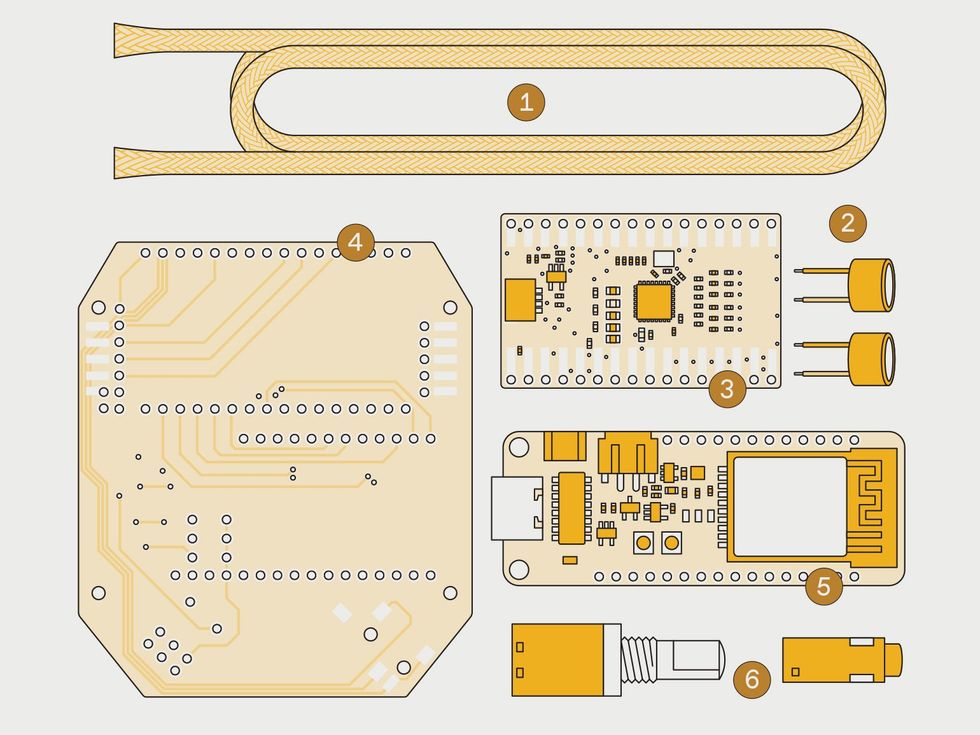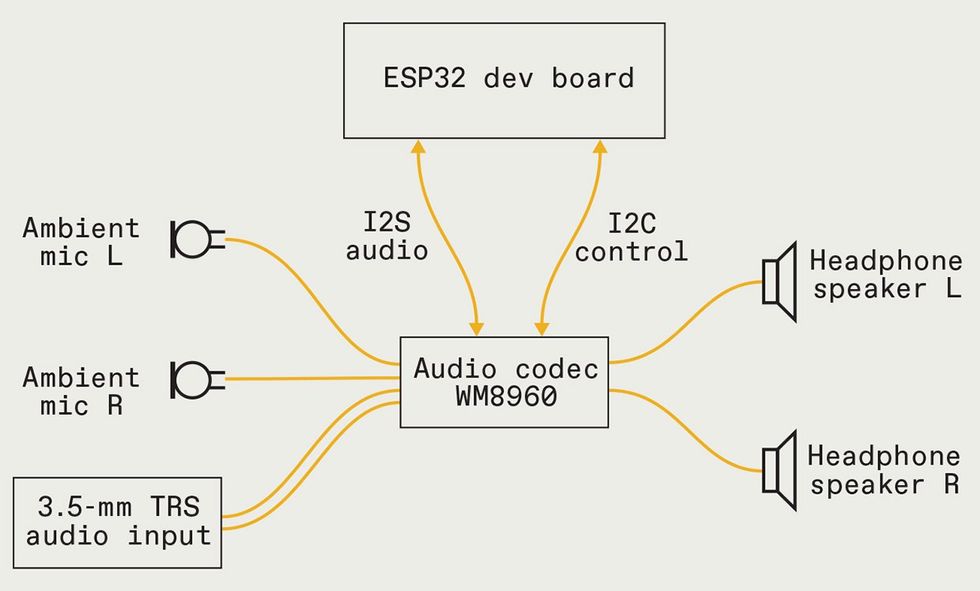
[ad_1]
Many people have got used to with the ability to hose down undesirable sound, due to the noise-cancellation era present in, as an example, Apple’s AirPods Professional earbuds. However this tech will get you best to this point: Noise cancellation works only for quite low frequencies, and the total listening to coverage that earbuds can be offering may be quite restricted. Earplugs or over-the-ear defenders are an possibility, however they block sought after in addition to undesirable sounds. There are commercial answers that cross by way of sounds in explicit frequency levels, however those are centered at speech. As a musician who performs loud track, I need a method to give protection to my listening to and so to pay attention myself, my bandmates, and the target audience with prime constancy.
For years, I’ve been seeking to make stronger my non-public audio-monitoring state of affairs with out going to the expense of the programs utilized by skilled traveling bands, which come with custom-molded earpieces. Now, after numerous variations of wiring issues in combination, or even designing my very own audio mixers, I in any case have a DIY resolution that works inside an inexpensive funds. My way was once to evolve an concept utilized in some pass-through programs, putting ambient microphones at the outdoor of sound-isolating headphones. I might seize the sign from those exterior mics at prime quality and feed it into the headphones on the desired quantity.
After all, more straightforward stated than carried out. For my first prototype, I purchased a collection of US $40 ear defenders that had a integrated AM/FM radio, which fed into small audio system within the ear “cans” and extracted the radio electronics to make some area. I then connected a series of breakout forums from my full-time employer, SparkFun Electronics: A $7 ICS-40180 MEMS microphone, a $6 TSH82 op-amp, and an $11 TPA2016D2 class-D amplifier. My preliminary trying out went ok, in that I may just pay attention the sound from the mics once I wore the defenders, however I temporarily spotted an issue.
 The writer wanted a correctly shielded grounded cable (1) to usher in a sign from the left microphone (2) to the audio codec board (3), which is fastened on a tradition circuit board (4) inside of the correct headphone. Additionally fastened at the board are the ESP32 microcontroller (5) and a quantity regulate and audio jack (6). James Provost
The writer wanted a correctly shielded grounded cable (1) to usher in a sign from the left microphone (2) to the audio codec board (3), which is fastened on a tradition circuit board (4) inside of the correct headphone. Additionally fastened at the board are the ESP32 microcontroller (5) and a quantity regulate and audio jack (6). James Provost
I’m a drummer. After I performed very gently on my drum set, the audio was once transparent, however once I hit a drum with even reasonable drive, the pass-through sign was rudely distorted, or clipped. Confused, I checked the specifications of the microphone. The datasheet indicated it had an acoustic overload level (AOP) of 124 decibels. It appeared like the microphone must be greater than able to dealing with an acoustic drum set—which, consistent with my calibrated sound-level meter, was once generating a height of best 115 dB all the way through my hardest-hitting taking part in.
The microphone’s breakout board applies a acquire of 64x, the use of two levels. My first idea was once to scale back this acquire. Perhaps the clipping was once going down at best the primary acquire level. Sadly, even with this acquire eradicated, the clipping remained. I then examined the uncooked MEMS microphone output by way of feeding it into some “professional grade” mic preamps. With this setup, I used to be in a position to look that the issue wasn’t the amplification levels however that the mics themselves had been generating the clipping. Via this take a look at, I realized a precious lesson: A mic’s indexed AOP is the purpose at which the microphone will produce a ten % overall harmonic distortion, and so noticeable clipping can in truth begin to occur neatly underneath this point.
I used to be at the hunt for some other affordable small MEMS mic that might take care of louder sound resources. I discovered the Vesper VM2020, with an excellent AOP of 149 dB! I spun up a brand new breakout board for the VM2020 and was once trying out it very quickly. Preliminary effects had been excellent—the VM2020 didn’t clip the sign regardless of how laborious I performed! On the other hand, because of the middling sensitivity of this microphone (–63 dB), it was once vital so as to add a large number of acquire to the sign. Blended with the microphone’s similarly middling signal-to-noise ratio of fifty dB, this ended in an excessive amount of hiss within the output for my musical wishes. I went at the hunt for but some other microphone. I discovered the $5 AOM-5035L by way of PUI Audio, which is an electret condenser sort. This microphone had 3 necessary specifications: prime AOP (135 dB), excellent sensitivity (–35 dB), and a greater signal-to-noise ratio of 75 dB.
 The WM8960 audio codec interprets incoming sound indicators—whether or not they’re analog from the microphones, an audio cable, or virtual indicators gained from the ESP32 microcontroller—into audible sounds {that a} wearer can pay attention. The ESP32 additionally configures the codec board on startup.James Provost
The WM8960 audio codec interprets incoming sound indicators—whether or not they’re analog from the microphones, an audio cable, or virtual indicators gained from the ESP32 microcontroller—into audible sounds {that a} wearer can pay attention. The ESP32 additionally configures the codec board on startup.James Provost
Across the time of discovering this microphone, I had simply finished some other breakout board for SparkFun. It was once for the audio codec chip by way of Wolfson, the $18 WM8960. This board was once extra suited to this undertaking than my earlier selection, the TPA2016D2. The WM8960 has a quieter preliminary acquire level that’s designed for microphones. On the other hand, I now wanted a microcontroller to initialize and regulate the WM8960. I selected the $10 ESP32 as a result of it could permit me to function the WM8960 and in addition settle for audio by the use of a Bluetooth connection from, say, my telephone, and move it to the WM8960.
I created a motherboard PCB to verify the entirety fitted well into the correct ear can of my hacked ear defenders. At the outdoor of each and every can I positioned a microphone to offer stereo sound. (An in depth step by step information is to be had at the SparkFun website online.) Quickly I used to be playing a blank audio sign without a clipping and no hiss all the way through my drum rehearsals. However in a final wrinkle, I spotted that every so often there was once a small whining noise that will range in pitch within the left audio channel. This was extra pronounced when the batteries had been getting low, and if I grew to become off the ESP32’s Bluetooth, probably the most noise would leave. In an try to remedy this, I first added a separate and devoted flooring connection from the left microphone again to the electronics in the correct ear can. This diminished the whine however didn’t take away it completely. I in any case used a correct shielded microphone cable to glue the microphone to the WM8960. This eradicated the noise totally. Luck! I’ve been taking part in away with safe listening to, and for lower than $100 and a few bench time, you may also have your very personal tradition set of Superheadphones!
[ad_2]